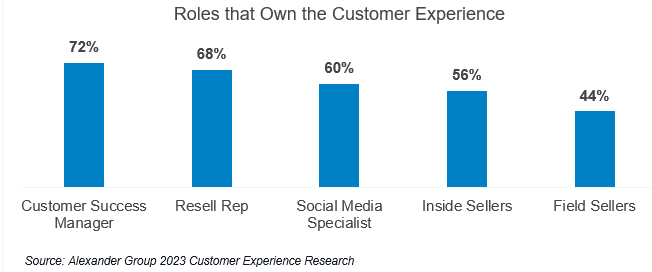Driving Customer Loyalty Through Customer Experience


Customer Experience is More Than Just Customer Service
Business service providers aspire to be more than merely vendors—they strive to be long-term partners with their customers. Customers rely on them to deliver solutions that not only meet their immediate needs and expectations but also provide the necessary resources to drive value and help grow their own businesses. This brings into play the concept of customer experience (CX), a much broader notion than customer service. A comprehensive CX program creates a lasting impression on the customer, one that reflects the service providers’ overall vision. Every aspect of the business contributes to shaping a CX that sets it apart from the competition.
Customers form their opinions about a company during each touchpoint of the customer journey, beyond just the product or service they buy. CX is the comprehensive engagement process they have with the brand. From the moment they land on the website, to the conversations they have with the sales team, to the delivery and support they receive after the purchase, every touchpoint matters. This signifies why customer experience is so crucial to the purchasing process. It sets the tone for what customers can expect from the solution and how it will solve their problems. And it doesn’t stop there. Proper and consistent account management ensures that customers become loyal advocates, whose feedback is heard and acted upon. CX is the key to building lasting relationships and growing the business.
Recent Alexander Group research shows that business services companies that invest in customer experience achieve greater profitable growth results (+16 points of higher revenue growth and +13 points of EBITDA margin) and realize higher customer retention at +36%, greater account expansion at +46% and more effective new logo acquisition at +27%.
The research reveals that CX leaders1 drive customer loyalty through four focus areas:
- CX Vision and Strategy
- Customer Engagement
- Goals and Measurement
- Process, Plays and Tools
CX Visions and Strategy
Companies with leading CX programs have a well-documented and communicated vision and strategy for CX that flows through their organizations. It starts at the top with leaders who commit to investing in a CX vision and empowering their teams to deliver. A successful CX strategy involves collaboration across the organization to understand customer profiles, optimize customer touchpoint processes and create value at every customer interaction. These activities go beyond standard customer-facing motions with Marketing, Sales and Service, as it also includes functions like HR, Finance and Revenue Operations to support the behind-the-scenes efforts. As an example, HR hires the right talent with extensive client management experience, while Finance enhances the ease of doing business through billing and contract responsibilities. Revenue Operations tracks how the business is doing from a CX perspective and identifies which metrics matter most. CX is not a silo, but a culture that connects the entire organization.
A company’s ownership approach to customer experience indicates a level of dedication and investment. Alexander Group’s research discovered three common ownership models for where CX sits within the organization.

Customer Engagement
Establishing a CX vision and strategy is a dynamic process that will evolve over time. However, there are tactical steps companies can take at the commercial level to help facilitate and move the process forward. One initiative is to define CX responsibilities within roles. The research revealed that 83% of CX leaders have taken this action. Beyond driving a CX culture, this means defining the rules of engagement and holding all team members and functions accountable for delivering CX excellence.
Post-sale roles, like customer success managers, were cited as the largest owners of CX. While this result is to be expected, not all client-facing roles hold a similar level of CX ownership. For example, direct selling roles may not be viewed as having as much ownership as marketing roles like social media specialists. This signifies that CX is really a team sport, involving roles across functions. However, there is also an opportunity to elevate CX ownership within these roles. Matching customer-facing roles with the right customer segments and personas is a way to bolster CX ownership within selling roles.

Goals & Measurement
Enhancing CX requires clear goals and trackable KPIs to measure progress over time. A customer’s experience is multi-dimensional and therefore requires a variety of KPIs to capture a full story. Companies nascent in their CX journey may overly rely on metrics like customer satisfaction scores to determine performance levels. CX leaders, however, have an expanded set of metrics they use to also emphasize financial outputs and their correlation to customer activity. CX leaders deepen their customer insights by connecting with their customers through meaningful activities like customer events, webinars and roundtables.
Popular tracking metrics used by CX leaders include:
- Customer conversion rates2
- Net revenue retention rates3
- Customer retention rates
- Customer satisfaction rates
- Net Promoter Score
Process, Plays and Tools
The most important part of any CX program is its execution, which requires a process to collect and analyze data on a regular cadence and turn those insights into action.
The following percentages of CX Leaders view measuring these activities as crucial to help understand their customers:

To act upon these insights, CX leaders set a regular cadence of internal cross-functional meetings to review the latest findings and revisit CX-related processes and policies.
These meetings then inform changes to day-to-day execution and often result in detailed CX playbooks, which often outline:
- CX expectations by customer segment
- Detailed customer and buyer personas
- Recommended external-facing talk tracks/talking points
- Internal rules of engagement by customer interaction
- FAQs
Conclusion
Customer experience goes well beyond just customer service, covering all interactions that customers have with a brand. It begins with creating a good first impression through marketing and brand awareness, showcasing value through sales interactions, and finally delivering that value in ongoing post-sale activities. Every function in the organization contributes to building a positive customer experience. By focusing on these four CX areas, companies can elevate their customer experience and position their organization as a leader in the market.
1CX Leaders are defined as the top quartile of the Alexander Group Customer Experience Index. The Customer Experience Index scores companies based on their CX maturity.
2Customer conversion rates: This metric measures the percentage of website visitors who take a desired action, such as making a purchase or filling out a form.
3Net Revenue Retention rate: This metric measures the recurring revenue generated from existing customers over a set period of time.

Need Help?
For more information, contact an Alexander Group Business Services practice lead or schedule a briefing of our latest customer experience research.



